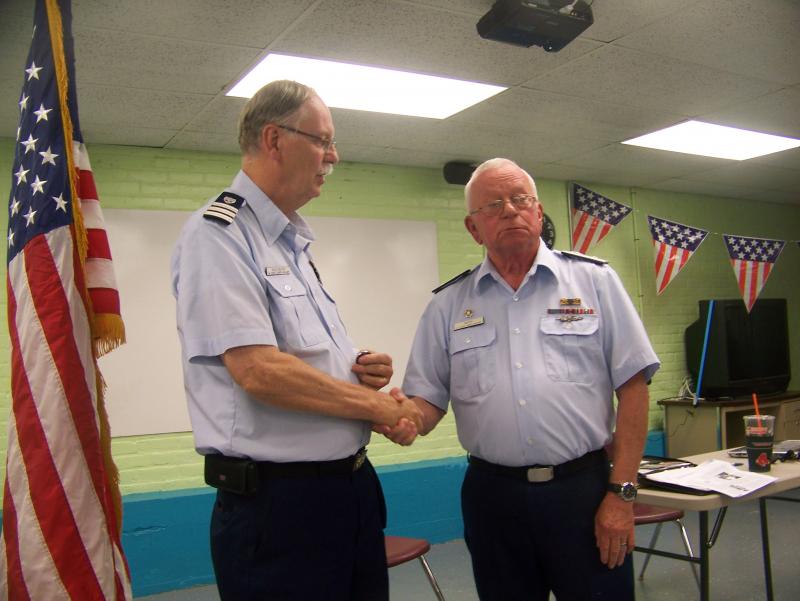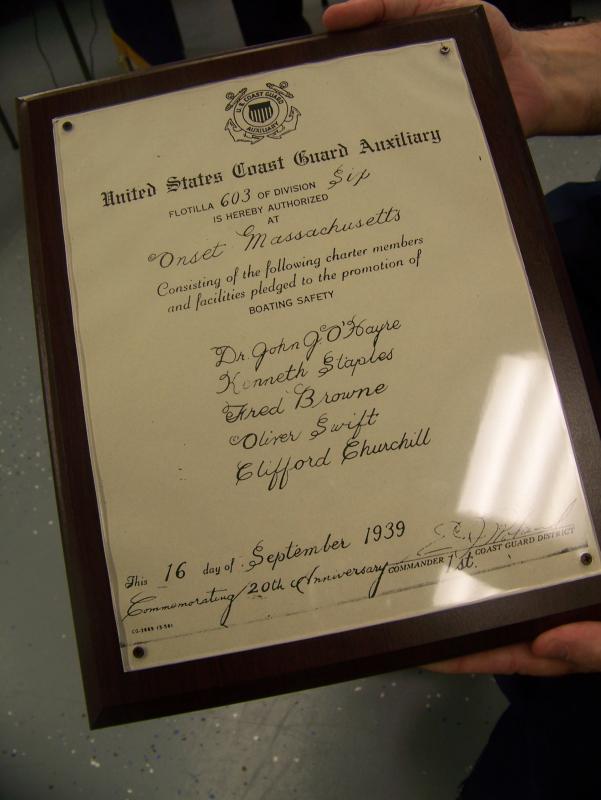Flotilla 63 celebrates 75 years on the high seas
For 75 years, the volunteers of the U.S. Coast Guard Onset-Marion Flotilla 63 have supported the Guard through hurricanes and search and rescue missions and promoted safety to keep boaters out of dangerous situations in the first place.
On Friday, members of the nation’s oldest continuously operating auxiliary celebrated its 75th anniversary.
“It’s a big honor for all of you,” said District Commodore Ron Booth. “I wasn’t around when this group started. I was close, but not quite.”
Created by congress in June 1939, the Coast Guard Auxiliary supports the Guard in all its missions except those that require law enforcement or military action.
The Onset-Marion Flotilla 63 was founded in Onset. The club moved to Brockton for a time and returned to Onset, but not for long.
“Hurricane Bob chased us out of Onset,” Flotilla 63 Commander Warren Washburn said. “Part of the yacht club we met in was washed away.”
Washburn, a Marion native who now lives in Falmouth, joined the auxiliary in 1972.
After the hurricane, Flotilla 63 started to meet in a Coast Guard Station in Sandwich. The group trained there until 2008. Membership was at an all-time low and action was needed.
“We were down to 12 members. Usually, we have anywhere between 30 and 40 people,” Washburn said.
Instead of disbanding, the group reached out to Flotilla 67 located in Marion.
“We asked them about merging because we didn’t want to lose the history of the 63,” Washburn said. “Flotilla 67 received us with open arms.”
Flotilla members now meet in the Marion Recreation Department where boating safety classes are offered to the public.
A six-week course is offered from February through April. It’s a core component of the auxiliary’s mission and one Washburn takes seriously.
“I started boating as a teen and would see people doing questionable things on the water,” Washburn said. “I figured there had to be a way to tell people how to be safe without being confrontational.”
He’s taught boating safety in area classrooms through the years.
“I did a lot of teaching, which I love,” he said. “I put a lot of energy into it.”
In addition to its educational mission, the auxiliary backs up the Coast Guard on the water.
In the early days, during World War II, auxiliaries up and down the east coast were charged with spotting German U-boats.
While that’s no longer the case, Washburn explained auxiliarists may still offer their vessel, known as a facility, for Coast Guard use.
The boats must meet strict requirements. Crew members are also subject to extensive training.
Washburn has helped tow stranded boaters away from the canal on a few occasions.
“It’s a great opportunity to work alongside the active Coast Guard,” he said. “They come to appreciate what we can offer.”
Auxiliary member Lee Harrison said he realized Flotilla 63’s potential when he was an active member of the Coast Guard.
Harrison served in the Guard for 27 years. In 1998, the Coast Guard changed a rule that previously prevented active members from joining the auxiliary.
Harrison signed up and served in both organizations until he retired from the Coast Guard in 2005.
“I wore two hats for awhile. I saw the value in what they were doing and became one of the first active duty Coast Guard members to joint he auxiliary.”
In the Guard, he participated in drug busts and other law enforcement actions.
In the Flotilla, the mission is different, but no less important.
“We want to give people the tools and knowledge that will help save their lives in a dangerous situation,” Harrison said. “Maybe more importantly, we try to get them to avoid danger in the first place.”















